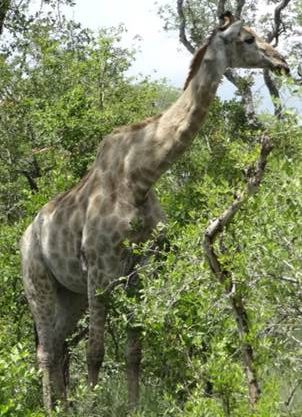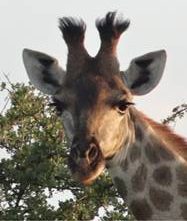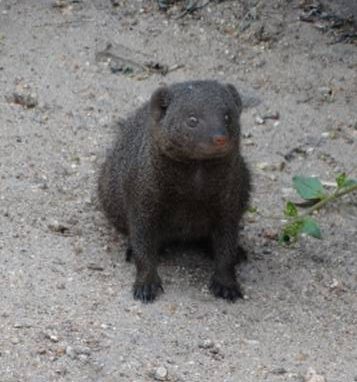RED ROCKS
Although we always refer to the route we are now going to follow as the Red Rocks route, it is officially known as the Shingwedzi Loop (S52), which lies to the south-west of the camp. As its official name implies, it follows the course of the Shingwedzi River. The northern entrance is but 5 km from the camp, but we are going to follow the H1-6 for a further 13 km to the southern entrance instead.

This northernmost stretch of the H1-6 is usually very rewarding with regard to game sightings with elephant, Kudu, Impala, warthogs and of course, giraffe. It is at this point that we are going to take a closer look at this unique and amazing creature. As can be seen in the photos below, they browse contentedly (without injury) on the thorniest of trees. This they can do because they have very tough, leathery tongues. Notice how they very carefully purse their lips away from the thorns!

Without a good view of this giraffe’s nether regions, I can confidently state it is a male. How? I look at his horns! Take a close look and then scroll down further to the next set of photos.

Carefully pursed lips!

Bald horns!


The two giraffes above are ladies. Do you notice that their horns are fully covered with hair? Their horns (officially ossicones) are also finer. You will also notice that they do not have such a pronounced bump (formed by another ossicone) on their foreheads. (Ignore the strange eyebrows of the lady on the right!)
I must in all honesty admit, though, that we have seen a female with bald(ish) horns down in the south near Phabeni. She was the oldest giraffe we have ever seen, so pale and gaunt she appeared ghost-like! However, a close look at her horns will show the difference between her bald spots and those of the giraffe bull we have already examined.


The hair on the horns is still long!

Below on the left is another male with bald stumps and the hair has been rubbed off his forehead bump as well. His cousin on the right even has signs of injury, both on his forehead and on the horn on the right.
Yes, you guessed it! This is why male giraffes have bald horns. Nothing like testosterone to get the guys fighting for dominance and the right to mate!


This was taken in poor light, early on a misty, overcast day.
A giraffe fight is something to see. At first it appears to be some sort of mating ritual as they stand next to each other, apparently lovingly swaying their necks together. If you notice they both have bald horns, you immediately know that a fight is in progress. If you cannot see their horns, then, when they swing their great necks outwards and then towards each other and you hear a thunderous crack as their necks and heads connect, you know this is no love match!
The fight sequence below took place in the south in the Pretorius Kop region. Unfortunately, for much of the time they were partially hidden by bush. They were also quite a distance away.

Preparing to swing their necks.

Legs apart, neck down.

Head swinging upwards.

Wham!
To complete our giraffe horn research, we turn to the right off the H1-6 onto the S101 (see map on right). This short loop brings us back into sight of the river which bends away from the road for a few kilometres. Here we find a young giraffe who is completely typical. All young giraffes have beautifully fuzzy horns. (We will see more of them later on the H1-7)


Above: Little Fuzzy Horn
Right: Blue-cheeked Starling

Below is a Kudu cow in the vegetation typical of this loop. There are many bare areas though, as seen above in the photo of the starling. More about Kudus later.


We come to the end of the loop and rejoin the H1-6. On the right we have a number of very clear views of the Shingwedzi River down in its channel. If you are lucky you will see something interesting on the river bed such as this guy who would have been quite an impressive tusker if he hadn’t lost one of them!
It fascinates me to see how the dry river beds often appear as dirt roads.

Below are another two views of the river along this route, with corresponding close-ups!


Hippo and Grey Heron


Woolly-necked Stork
We now reach the southern entrance to the Shingwedzi Loop (the S52), but before we turn off onto it, I want to travel a few kilometres further on the H1-6 towards Mopani. It was here that we had our one and only sighting of Wild Dogs in the northern Park. We seem to have just missed the pack as we only saw two individuals. They must have been hunting for they swiftly disappeared. The sighting was very brief and I only had time to take one shot.

African Wild Dog or Painted Wolf
Over the years we have been blessed with a number of sightings of Wild Dogs but they have all been down south. One of the best was near Satara on the Orpen Road (H7) just west of the Nsemani Dam. It was a pack of about twenty dogs and they were there the whole morning. We saw them on the way to Orpen and they were still there when we returned! Choosing one shot was very difficult, but I eventually settled on the one below as it illustrates so perfectly why they are known as Painted Wolves. Each and every dog has a unique colour pattern. There are only two colour patterns they have in common. They all have dark muzzles with a pronounced stripe running up between their eyes to between their ears, and each dog has a white-tipped tail.


We turn back now to the turn-off onto the Shingwedzi Loop which is now on our left. The famous Kruger landmark of Red Rocks is but a kilometre or two away. The viewpoint is marked on the map with a binoculars icon. We have been here at different times of the day and would advise visitors to make it a morning trip. In the afternoons, the sun will be directly in your eyes and the red effect is almost completely lost. In the mornings, with the sun behind you, it is quite a spectacular sight. As with all viewpoints in Kruger, you are allowed to alight from your vehicles.

Red Rocks looking upstream.
When the Shingwedzi is in full spate over these rocks it must be a sight to behold!
(Excepting that you then won’t be able to see the red rocks, of course.)
Below are two photos taken at the same viewpoint but looking downstream.

Summer

Autumn
Somewhere on the lower loop between Red Rocks and the Silwervis Dam, we had one of our best sightings of Dwarf Mongoose, the smallest of the eight species of mongoose found in the Park. They are tiny creatures and, if you are so fortunate as to find them at home, or where they are foraging, they will provide much entertainment.
As we came around a corner, we saw this lone little guy sitting on a road reinforcement warming himself in the early morning sunlight.


This immediately alerted us and we looked out for the rest of his family. They are highly sociable and live in large groups, so if you see one, the others are not far away. Sure enough, a short distance further on we found the rest of the group searching for tasty snacks under stones. There were about a dozen of them across a deep donga (South African word for a gully formed by water erosion), but they are active, quick and agile and it was impossible to photograph the whole band together.


The mopane leaves in the photos above give some idea of how small this mongoose is. To give you a better perspective I include two photos taken down south. The first was taken in the Pretorius Kop camp. An entrance to their burrow was inside the camp, not far from our hut and they paid us a visit every evening. (Although they are incredibly cute, they can be a nuisance, and campers tend to look at them with a rather jaundiced eye. They get into everything!) The second was taken on the S21, south of Skukuza, on our way to Mopani.



They are nervous little things, so if you spot them at the side of the road, your sighting will be brief as they will be bound to duck into the grass or the nearest hollow log. However, all is not lost, for they are also incurably curious. If you stop and wait, it will not be long before they come out again to see what you are up to. We once had two such opportunities within an hour on the S21. This little guy came and sat right next to the Isuzu and gazed up at us quite earnestly for several minutes. Once again it was very overcast, so the photo is not as defined as I would have liked.

Slender Mongoose
There are seven other mongoose species in the Park, of which we have seen two, the Banded Mongoose and the Slender Mongoose. The most frequent sightings have been of the Slender Mongoose, but also the most frustrating. They are solitary creatures and very active and you are most likely to see them running across the road in front of you and then promptly disappearing into the grassy verge. We were lucky indeed to get the one seen on the left as it was sniffing at something on the road and paid no attention to us. (This was near Afsaal Picnic Spot in the south.)
The Banded Mongoose, like the Dwarf, is a sociable creature so you always find them in troops. In all the years of Park visits, we had only seen them three or four times before, once along the Kanniedood, but they were on the move and impossible to photograph. So you can imagine our delight when a troop of them (with little ones!) came into the camp at Crocodile Bridge, and foraged in an area behind our hut. Unfortunately, it was late afternoon and overcast, so only a few of our photos were okay - not one was really good

Banded Mongoose
Let’s get back to the Shingwedzi Loop!
At the point where the S52 (Shingwedzi Loop) crosses the river lies the Silwervis Dam. (Afrikaans for Silver Fish) You can see it on the map in the lower left hand corner. It was here that we had one of our more exasperating elephant sightings.
Right before you turn the sharp bend to cross the river, there is a wonderful view of part of the dam. We noticed a number of elephants under the trees and at the water’s edge, but they were far enough away from the road not to be of concern.

But, as we turned the corner and prepared to cross the low water bridge, we saw a bull already on the bridge. Behind him were several more, clearly intending to cross over. The herd was a lot larger than it had appeared to be!
Take note of the attitude of the guy on the bridge. When he saw us he stopped in his tracks, his legs planted firmly and shook his head at us. Then he turned slightly and did the old lift-one-leg-up thing. He was too far away to check for signs of the musth, but his intentions were clear. (Just try your luck and see how fast you land in the dam, you smelly, noisy tin box!)

Shaking his head.

Lifting his leg.
There was only one thing to do. We reversed back up and round the steep bend and waited.
And waited. Obviously, this rather large group of bulls was in no hurry at all. We decided that this was as good a place as any to have our breakfast.

The view of the bridge through the gap from where we waited.

They knew where we were!
Half an hour later, we had finished our breakfast, and, from what we could see, they had all crossed the bridge. We ventured round the bend to see what they were up to, and there the last stragglers were, dawdling around near the road! We waited for some time longer. At last there was only one left, but he was off the road and right at the edge of the water. We decided to make it quick. Ready, steady, go! We sailed past and he whirled round and told us exactly what he thought of us!

Dawdle, dawdle, dawdle...

And don’t come back!
The Shingwedzi Loop now heads back north on the other side of the river.

We have never seen anything spectacular along the northern loop. There are not many places where you can actually see the river, and the area is rather arid. At different times we have seen buffalo lying under bushes in the heat of the day, giraffe, and, of course, the ubiquitous Impala. We did once have a sighting of Steenbok (see below), I think the only time we have seen this small antelope in the Shingwedzi area. (Steenbok is Afrikaans for stone buck. The ‘ee’ of steen, is pronounced ‘ea’ as in ear. Thus ST-EA[R]-N-bawk.)
Although the same height as the Sharpe’s Grysbok, they average a few kilograms more, so they are slightly larger and, as with the Grysbok, the males and females are the same size. Like them too, they are very solitary animals. If you see two together, you can be almost sure it is a mother with her lamb. If the one has horns and appears to be a mature male, then you have probably stumbled onto a breeding pair. (As we saw in a previous chapter near Mopani.) It is suspected, as with the Sharpe’s Grysbok, that they do occur in monogamous pairs that share a territory, but if so, they give each other plenty of space!
The pair in the photo below is probably a breeding pair, and not mother and lamb, as the ram on the right did seem to be mature. It is not a good photo (taken with my first and very basic camera), and the ewe is camaflouged by the tree stump on the left, but it does give an idea of the vegetation (almost exclusively mopane, and in this case trees, not scrub) on the northern side of the loop.

I have included a clear photo of each sex taken elsewhere. The photo of the ram was taken near Mopani, and the ewe near Tshokwane. They are beautiful little creatures!

Steenbok ram

Steenbok ewe
If we were advising anyone wanting to do this route, but with limited time, we would encourage a morning visit, entering the Shingwedzi Loop via the southern entrance. From the Red Rocks viewpoint you could then continue on the lower loop of the S52 past Silwervis to the upper loop. About 12 km from Silwervis, there is a turn-off back to the Red Rocks viewpoint. You can skip the small loop to the actual viewpoint and head back to the H1-6 to return to Shingwedzi. By this time there will also be more thirsty animals making their way to the river along the H1-6.

In conclusion I would add only that although the Shingwedzi Loop is not the most productive of routes, you never know what you are going to see… which is part of the charm of Kruger!